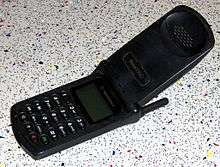Motorola StarTAC
 A GSM Motorola StarTAC | |
| Manufacturer | Motorola |
|---|---|
| Compatible networks | AMPS, CDMA, TDMA, GSM |
| First released | January 3, 1996 |
| Predecessor | Motorola MicroTAC series |
| Successor | Motorola RAZR[1] |
| Dimensions | 94 mm × 55 mm × 19 mm (130) |
| Weight | 88 g |
| Display |
Digital: LCD AMPS (Analog): Segment LED, Alphanumeric LED |
The Motorola StarTAC is a clamshell mobile phone manufactured by Motorola. It was released on January 3, 1996, being the first ever clamshell/flip mobile phone.[2] The StarTAC is the successor of the MicroTAC, a semi-clamshell design that had been launched in 1989.[3] Whereas the MicroTAC's shell folded down from below the keypad, the StarTAC folded up from above the display. In 2005, PC World put StarTAC at #6 in The 50 Greatest Gadgets of the Past 50 Years.[2]
The StarTAC was among the first mobile phones to gain widespread consumer adoption; approximately 60 million StarTACs were sold.
Release
Motorola applied for the StarTAC trademark name in September 1995. The StarTAC was unveiled in North America on January 3, 1996.[4] Then the smallest cell phone available, this AMPS phone was an immediate success. Successor TDMA and CDMA StarTACs were equally popular. GSM models were available in North America through Powertel, VoiceStream and other early GSM carriers. The StarTAC, which closely resembles Star Trek´s Communicator,[5] remained popular until the early 2000s, appearing in many Hollywood movies of the period such as 8mm starring Nicolas Cage. Many MicroTAC owners switched to this particular model due to its compact size and light weight. During its initial launch, magazine ads for the phone would include an actual size cardboard facsimile that could be pulled from the page to demonstrate the diminutive nature of the device.
The Motorola StarTAC mobile phone was introduced at the price of $1000.[6]

Key features
Some key features of the Motorola StarTAC were:
- SMS text messages, although only the later digital models had the capability to send messages.
- Introduced clamshell design
- 88 grams[7] (3.1 ounces[4])
- It could use an optional lithium-ion battery, at a time when most phones were restricted to lower capacity NiMH batteries
- Was one of the first cellular phones to introduce vibrate alert as an alternative to a ringtone.
- Featured a persistent flashing green indicator to indicate that the device had a network connection.
StarTAC 2004
The StarTAC name was revived in 2004 for a new model designed for the South Korean market. It had:
- A 128×160 262,000 TFT Color LCD
- 64-channel sound
- A Mobile Banking feature supported by SK Telecom
- A 2,800-entry contact book
In addition, a version with an 18K gold directional keypad and brightwork was released as StarTAC 2004 SE.
The regular edition was released without the Mobile Banking function as the Motorola V628 in China. The 18K gold edition remained Korea-only.
StarTAC III
Motorola once again revived the StarTAC by announcing the StarTAC III on February 27, 2007.[8]
Model list
Analog phones
- StarTAC 3000
- StarTAC 6000
- StarTAC 6500
- StarTAC 8500
- StarTAC 8600
Digital phones
- StarTAC 70
- StarTAC 75 - GSM 1800[9]
- StarTAC 75+
- StarTAC 80
- StarTAC 85 - GSM 900[10]
- StarTAC 130 - GSM 900[11]
- StarTAC 7000g - GSM 1900
- StarTAC 8000g - GSM 1900
- StarTAC Rainbow
- ST7760 (AMPS/TDMA)
- ST7762 (AMPS/TDMA)
- ST7790 (AMPS/TDMA)
- 80071WNBPA (FCC IHDT5VG1) AMPS/TDMA (832/2412 MHz)
- ST7797 (Tri Mode/Dual Band 800/1900 MHz. TDMA/800 MHz. AMPS)
- ST7860 (Dual Mode/Single Band 800 MHz. CDMA/AMPS)
- ST7867w (Dual Mode/Dual Band 1900 MHz. CDMA/800 MHz. AMPS)
- ST7868 (Tri Mode/Dual Band 800/1900 MHz. CDMA/800 MHz. AMPS)
- ST7890 (Tri Mode TDMA?)
- ST7897 (Dual Band TDMA)
- StarTAC 2004
- StarTAC III
Lekki
In October 2010, French company Lekki, who revamp iconic and vintage products from the 1990s, refurbished StarTACs in new colorful covers.[12] They are selling it for €220.[13]
See also
References
- ↑ Matt Hickey (27 February 2007). "StarTAC III: Back on the Streets". TechCrunch. AOL.
- 1 2 Tynan, Dan (2005-12-24). "The 50 Greatest Gadgets of the Past 50 Years". PC World. p. 2. Retrieved 2006-09-10.
- ↑ "Motorola introduces ultra lite 5.9 ounce cellular telephone - MicroTac Ultra Lite Telephone" (Press release). Mobile Phone News; PBI Media; Gale Group. 1992-02-10. Retrieved 2006-09-10.
- 1 2 "The smallest cell phone". Milwaukee Journal Sentinel. 1996-01-04. Retrieved 2006-09-10.
- ↑ Ha, Peter (October 25, 2010). "All-Time 100 Gadgets: Motorola StarTAC". Time Magazine. Retrieved August 1, 2016.
- ↑ Baguley, Richard (May 31, 2013). "The Gadget We Miss: The Motorola StarTAC". Retrieved August 1, 2016.
- ↑ "Motorola StarTAC Cellular Phone". Integrated Electronics Engineering Center. August 1996. Retrieved 2006-09-10.
- ↑ Motorola throws back, unveils StarTac III MS900
- ↑ "Motorola StarTAC 75".
- ↑ "Motorola StarTAC 85".
- ↑ "Motorola StarTAC 130".
- ↑ Kat Hannaford. "The Motorola StarTAC is Back, in Yellow". Gizmodo. Gawker Media.
- ↑ "Lekki - Vintage mobile phones and consoles". Lekki. Archived from the original on 2013-05-27.